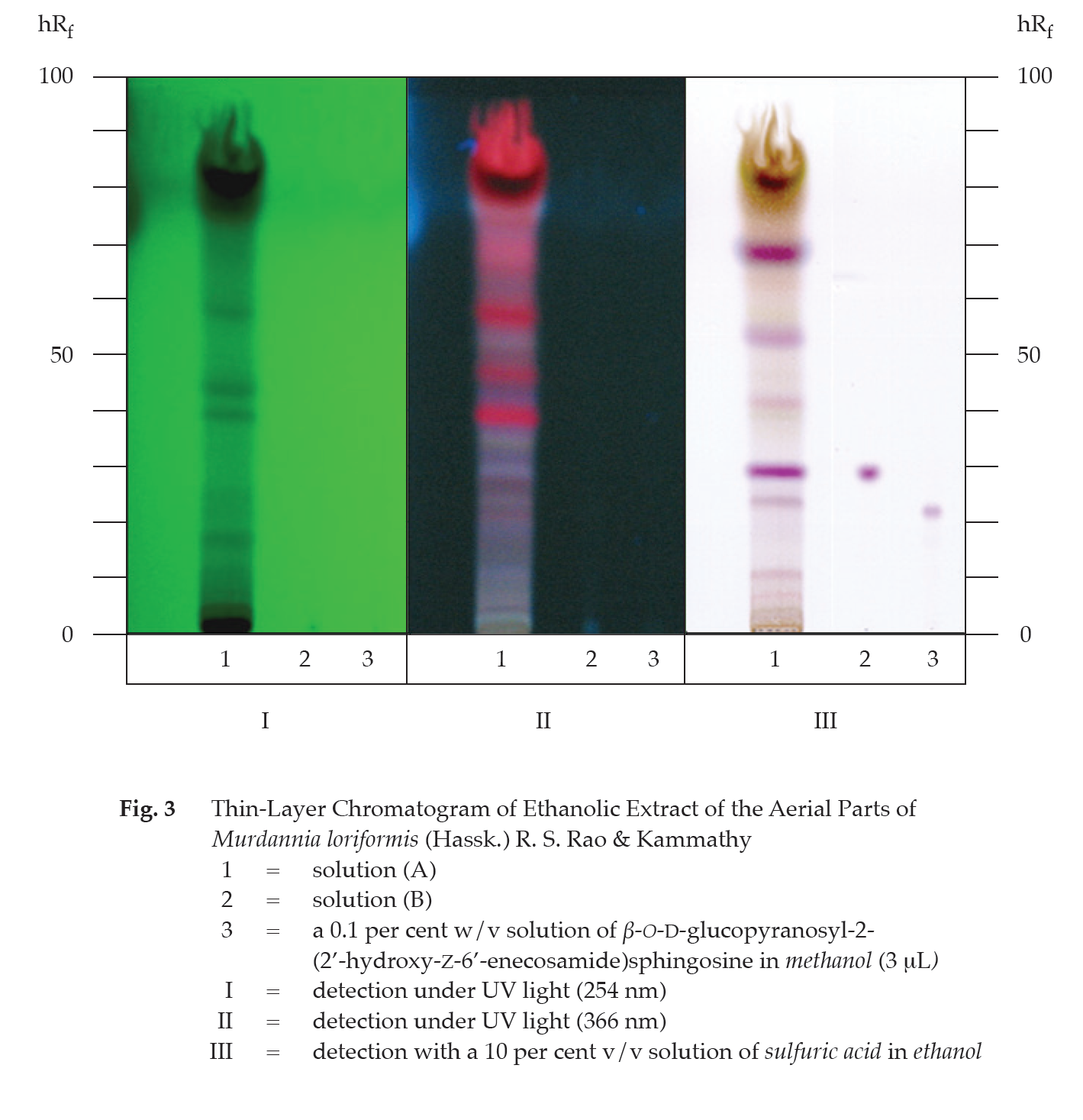ตำรามาตรฐานยาสมุนไพรไทย
Thai Herbal Pharmacopoeia
สำนักยาและวัตถุเสพติด กรมวิทยาศาสตร์การแพทย์ กระทรวงสาธารณสุข
Bureau of Drug and Narcotic, Department of Medical Sciences, Ministry of Public Health(Tinospora crispa (L.) Hook.f. & Thomson)
(Nelumbo nucifera Gaertn.)
(Centella asiatica (L.) Urb.)
(Centella Dry Extract)
(Centella Cream)
(Mesua ferrea L.)
(Piper sarmentosum Roxb.)
(Piper sarmentosum Roxb.)
(Pterocarpus santalinus L. f.)
(Santalum album L.)
(Senna tora (L.) Roxb.)
(Senna alata (L.) Roxb.)
(Senna Alata Tea)
(Piper retrofractum Vahl)
(Myristica fragrans Houtt)
(Andrographis paniculata (Burm. f.) Nees)
(Andrographis Capsules)
(Allium ascalonicum L.)
(Ocimum tenuiflorum L.)
(Curcuma longa L.)
(Turmeric Capsules)
(Turmeric Dry Extract)
(Turmeric Dry Extract Capsules)
(Arcangelisia flava (L.) Merr.)
(Curcuma sp.)
Harrisonia perforata (Blanco) Merr.
(Aristolochia pierrei Lecomte)
(Zingiber officinale Roscoe)
(Ginger Capsules)
(Ginger Tea)
(Cassia fistula L.)
(Nardostachys jatamansi (D. Don) DC.)
(Angelica sinensis (Oliv.) Diels)
Artemisia annua L.
(Ligusticum sinense Oliv. cv. Chuanxiong)
(Neopicrorhiza scrophulariiflora Pennell)
(Atractylodes lancea (Thunb.) DC.)
(Aucklandia lappa Decne)
(Terminalia chebula Retz.)
(Angelica dahurica (Hoffm.) Benth. & Hook. f. ex Franch. & Sav. var. dahurica)
(Kaempferia parviflora Wall. ex Baker)
(Hibiscus sabdariffa L.)
(Roselle Tea)
(Allium sativum L.)
(Zingiber zerumbet (L.) Sm.)
(Wurfbainia testacea (Ridl.) Škorničk.& A. D. Poulsen)
(Cannabis sativa L.)
(Myristica fragrans Houtt)
(Dracaena cochinchinensis (Lour.) S. C. Chen)
(Ficus racemosa L.)
(Hyptis suaveolens (L.) Poit.)
Clerodendrum indicum (L.) Kuntze
(Phyllanthus emblica L.)
(Citrus hystrix DC.)
(Citrus hystrix DC.)
(Areca catechu L.)
(Momordica charantia L.)
Moringa oleifera Lam.
(Aegle marmelos (L.) Corrêa)
(Solanum trilobatum L.)
(Morus alba L.)
Gynostemma pentaphyllum(Thunb.)
Makino
(Clinacanthus nutans (Burm. f.) Lindau)
(Cissus quadrangularis L.)
(Mimusops elengi L.)
(Zingiber montanum (J. König) Link. ex A. Dietr.)
(Piper betle L.)
(Capsicum annuum L.)
(Capsicum Oleoresin)
(Capsicum Gel)
(Piper nigrum L.)
(Piper nigrum L.)
(Eurycoma longifolia Jack)
(Thunbergia laurifolia Lindl.)
(Piper wallichii (Miq.) Hand.-Mazz.)
Senna garrettiana (Craib) H. S. Irwin & Barneby
(Terminalia bellirica (Gaertn.) Roxb.)
(Terminalia chebula Retz.)
(Caesalpinia bonduc (L.) H. Roxb.)
(Tarlmounia elliptica (DC.) H. Rob., S. C. Keeley, Skvaria & R. Chan)
(Hog Creeper Vine Dry Extract Capsiles)
(Hog Creeper Vine Dry Extract)
(Brachypterum scandens (Roxb.) Miq.)
(Lepidium sativum L.)
(Nigella sativa L.)
(Cuminum cyminum L.)
(Foeniculum vulgare Mill.)
(Plantago ovata Forssk.)
(Pimpinella anisum L.)
(Carum carvi L.)
(Anethum graveolens L.)
(Trachyspermum ammi (L.) Sprague)
Albizia procera (Roxb.) Benth.
(Acorus calamus L.)
(Tiliacora triandra (Colebr.) Diels)
Cyanthillium cinereum (L.) H. Rob.
(Orthosiphon aristatus (Blume) Miq.)
Murdannia loriformis (Hassk.) R. S. Rao & Kammathy
(Capparis micracantha DC.)
(Chrysopogon zizanioides (L.) Roberty)
(Cyperus rotundus L.)
(Cannabis sativa L.)
(Syzygium aromaticum (L.) Merr. & L. M. Perry)
(Boesenbergia rotunda (L.) Mansf.)
(Acanthus ebracteatus Vahl)
(Acanthus ilicifolius L.)
(Kaempferia galanga L.)
(Curcuma comosa Roxb.)
Betula alnoides Buch.-Ham. ex D. Don
Cannabis sativa L.
Carthamus tinctorius L
Mitragyna speciosa (Korth.) Havil
Mallotus repandus (Rottler) Müll. Arg
Azadirachta indica A. Juss. var. siamensis Valeton
Azadirachta indica A. Juss. var. siamensis Valeton
Punica granatum L.
Rhinacanthus nasutus (L.) Kurz
Baliospermum solanifolium (Burm.) Suresh
Curcuma aeruginosa Roxb
Boesenbergia kingii Mood & L. M. Prince
Senegalia rugata (Lam.) Britton & Rose
Acacia concinna (Willd.) DC.
Senegalia rugata (Lam.) Britton & Rose
Acacia concinna (Willd.) DC.
Senna alexandriana Mill. var. alexandriana
Cassia acutifolia Delile, Cassia angustifolia Vahl
Butea superba Roxb. ex Willd.
[Plaso superba (Roxb. ex Willd.) Kuntze, Rudolphia superba (Roxb. ex Willd.) Poir.
Pueraria candollei Graham
ex Benth. var. mirifica (Airy Shaw & Suvat.) Niyomdham
Streblus asper Lour.
Suregada multiflora (A. Juss.) Baill. (Gelonium
multiflorum A. Juss.
Plumbago zeylanica L.
Plumbago indica L.
Biancaea sappan (L.) Tod.
Ziziphus attopensis Pierre
Streblus asper Lour.
Justicia gendarussa Burm. f.
Enhalus acoroides (L. f.) Royle
Bridelia ovata Decne.
Tamarindus indica L.
Citrus × aurantiifolia (Christm.) Swingle
Garcinia mangostana L.
Blumea balsamifera (L.) DC
Persicaria odorata (Lour.) Soják
Zingiber montanum (J. König) Link ex A. Dietr.
Mammea siamensis (Miq.) T. Anderson
Citrus maxima (Burm.) Merr.
Citrus × aurantium L. ‘Som Sa’
Punica granatum L.
Rhinacanthus nasutus (L.) Kurz
Murdannia Loriformis Herb is the dried aerial part of Murdannia loriformis (Hassk.) R. S. Rao & Kammathy [Aneilema angustifolium N. E. Br., A. loriforme Hassk., A. terminale Wight] (Family Commelinaceae), Herbarium Specimen Number: BKF 133708, Crude Drug Number: DMSc 1174.
Constituents Murdannia Loriformis Herb contains a glycosphingolipid which is β-O-Dglucopyranosyl-2-(2’-hydroxy-Z-6’-enecosamide)sphingosine. It also contains glycosidic compounds which are β-sitosteryl-β-D-glucoside and digalactosyl diglycerides and inorganic salts including sodium, potassium and magnesium.
Description of the plant (Figs. 1a, 1b) Perennial rosette herb, diffuse or ascending, 15 to 50(–100) cm long, glabrous or puberulous, rarely densely hirsute. Leaves simple, spirally arranged, blade linear, basal leaves 10 to 20 cm long, 1 to 1.5 cm wide, cauline leaves shorter, apex acute, base clasping stem into sheath, margin proximally ciliate, glabrous, rarely densely hirsutulous, parallel-veined; leaf sheath ciliate only on one side of sheath mouth. Inflorescence cincinnus, terminal, sometimes axillary, solitary or 2 or 3 forming a panicle, subcapitate of several densely arranged flowers; peduncle 3 to 6 cm long; bract caducous; bracteole suborbicular, 4 to 8 mm long, 4 to 6 mm wide, translucent, greenish. Flower with pedicel about 3 mm long, erect, slightly curved, up to 4 mm long when in fruit; sepals 3, translucent green, ovate-elliptic, 3 to 5 mm long, 2 to 3 mm wide; petals 3, whitish, purplish to bluish, obovate-orbicular, 3.5 to 6 mm long, 3 to 5 mm wide; fertile stamens 2, filament pubescent; staminodes 4, 1 antisepalous and 3 antipetalous; ovary superior, 3-loculed. Fruit capsule, ovoid-globose, 3 to 4 mm long, trigonous. Seeds 2 per locule, brown, radiate striate, finely white reticulate.
Description Odour, faint and characteristic; taste, irritating.
Macroscopical (Fig. 1a) Aerial part, greenish grey; leaves, varied in size and shape, linear, longitudinally wrinkled and twisted, glabrous.
Microscopical (Figs. 2a, 2b, 2c, 2d) Transverse section of the leaf through the midrib shows upper epidermis, mesophyll, vascular bundles, and lower epidermis. Upper epidermis, a layer of rectangular cells, with a few multicellular uniserate trichomes and covering reticulate cuticle striation. Mesophyll: 3 to 6 layers of large polygonal parenchyma cells in the upper part, some containing yellowish brown pigment; 2 to 8 layers of small round chlorenchyma; 1 to 3 layers of small polygonal parenchyma cells in the lower part.
Vascular bundle, phloem tissue and xylem tissue, surrounded by 1 to 3 layers of bundle sheath. Lower epidermis, rectangular cells, multicellular uniseriate trichomes, hexacytic stomata, and covering reticulate cuticle striation. Collenchyma, 2 or 3 layers, found beneath lower epidermis in the midrib.
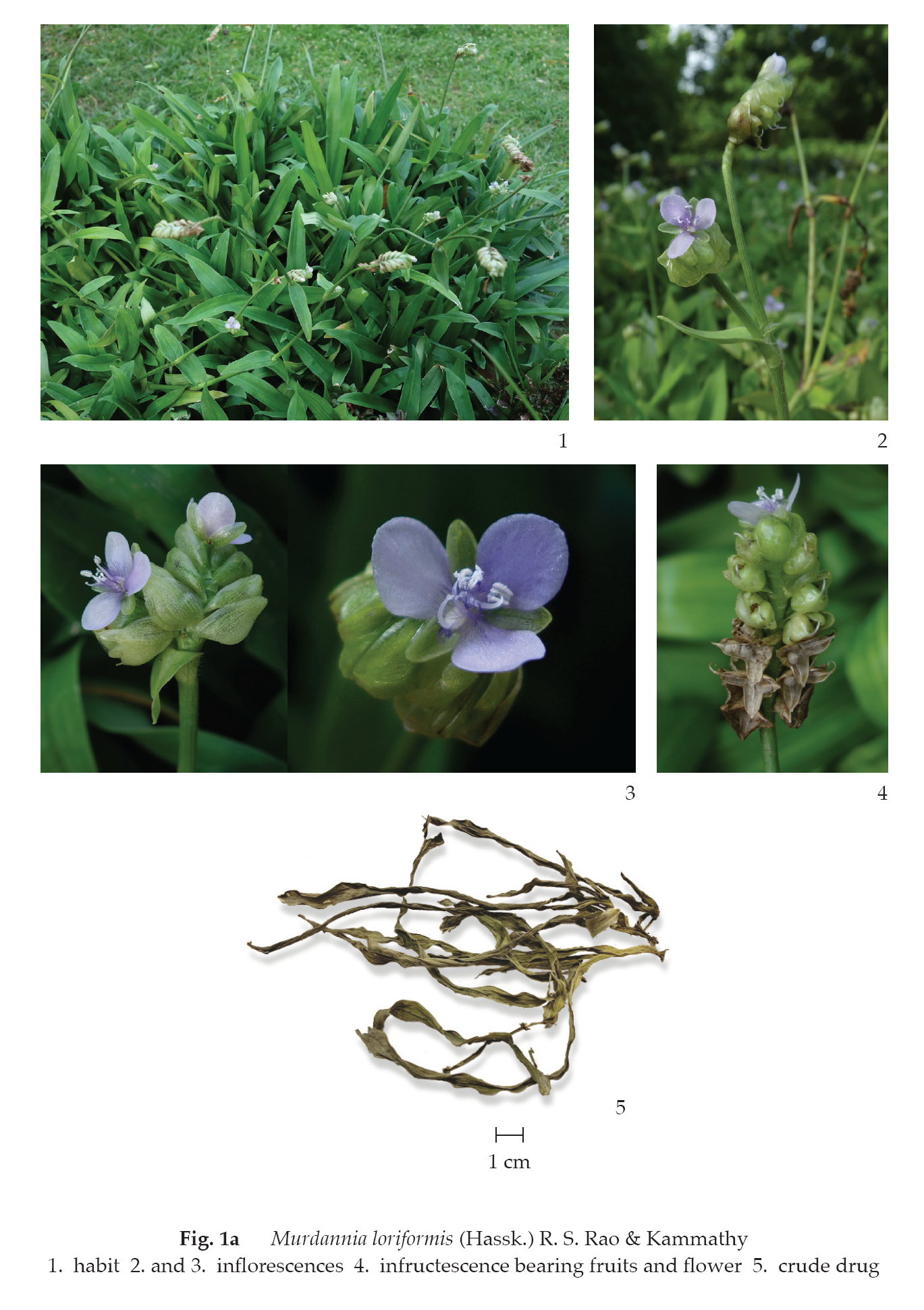
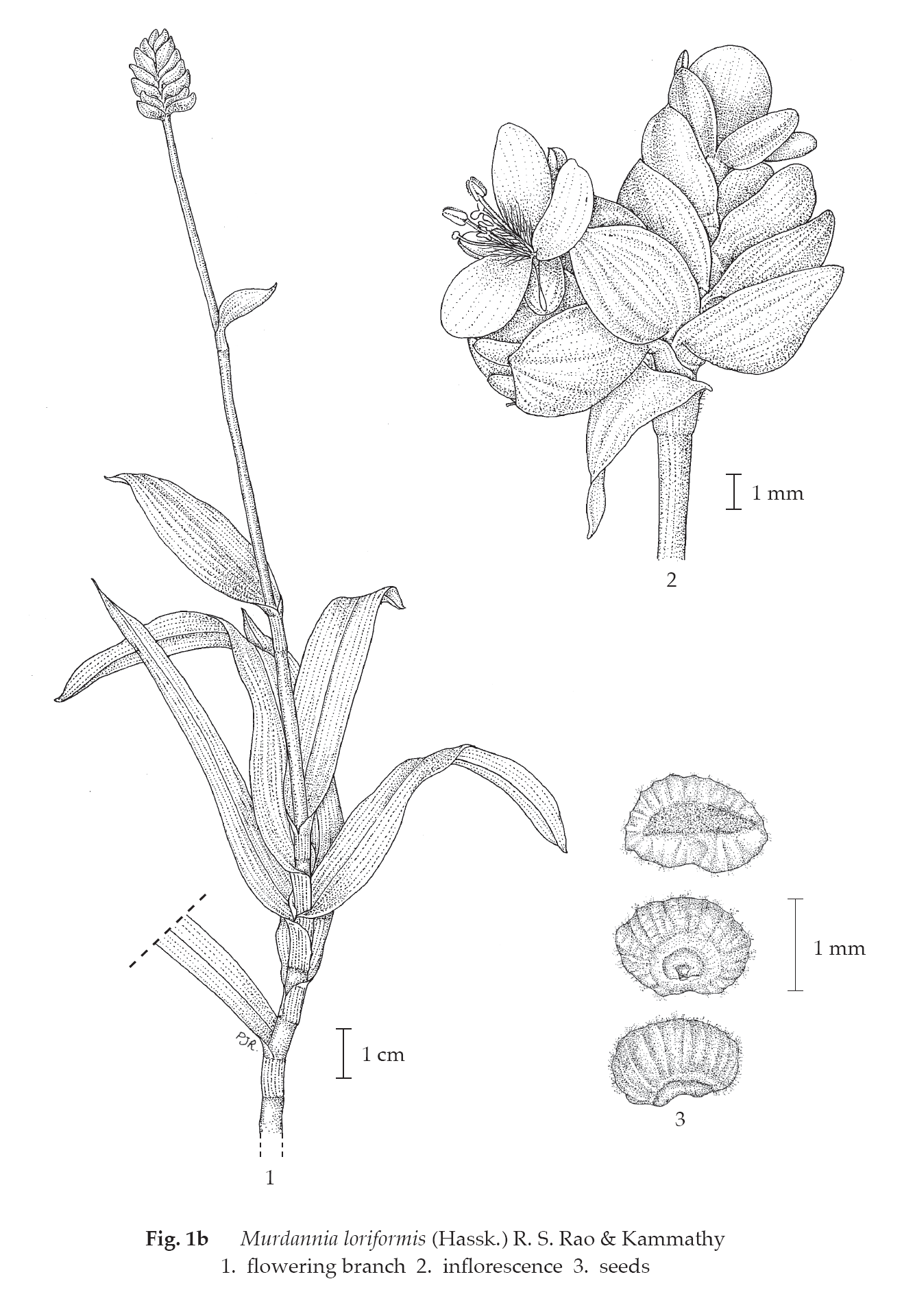
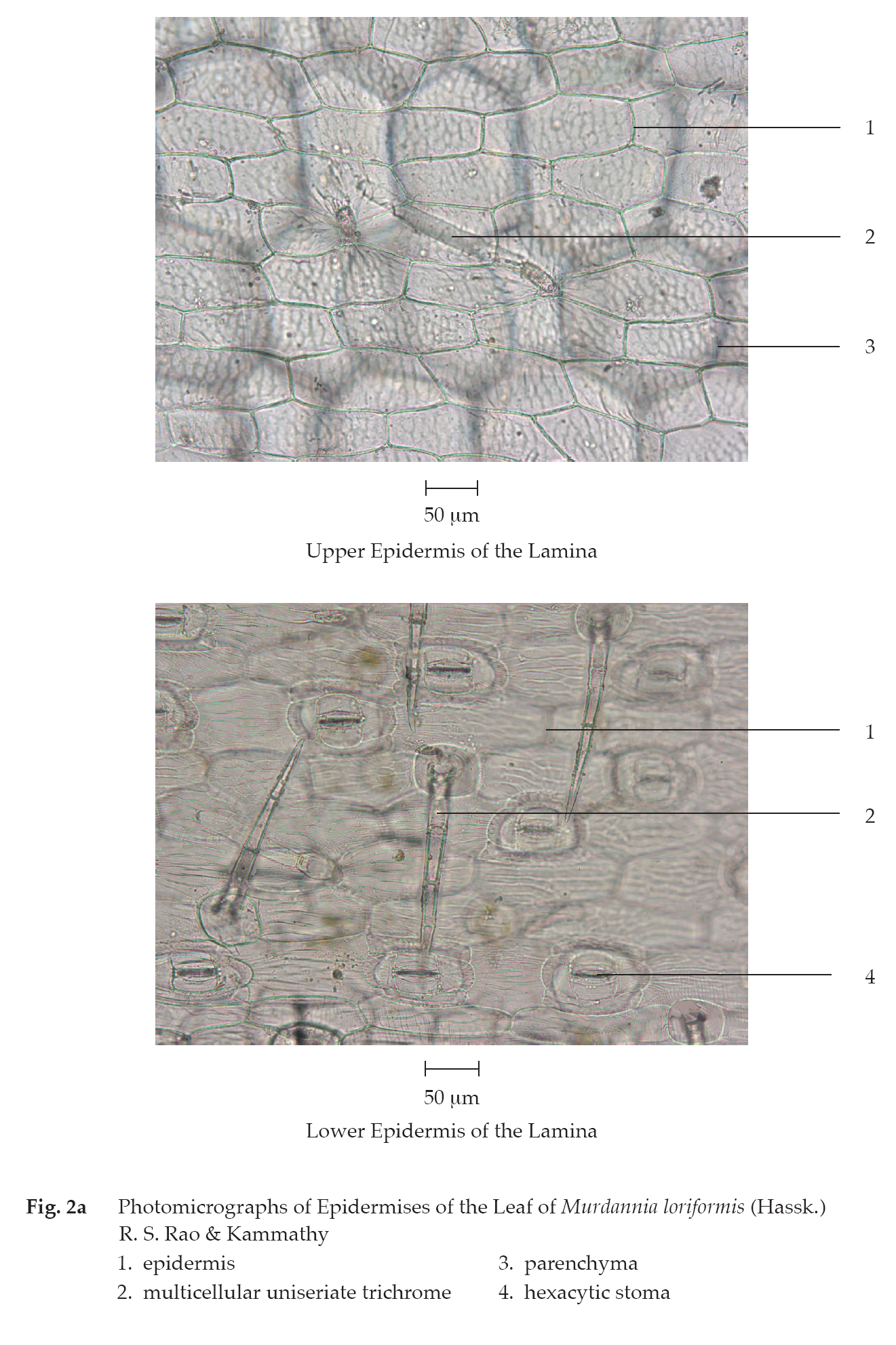
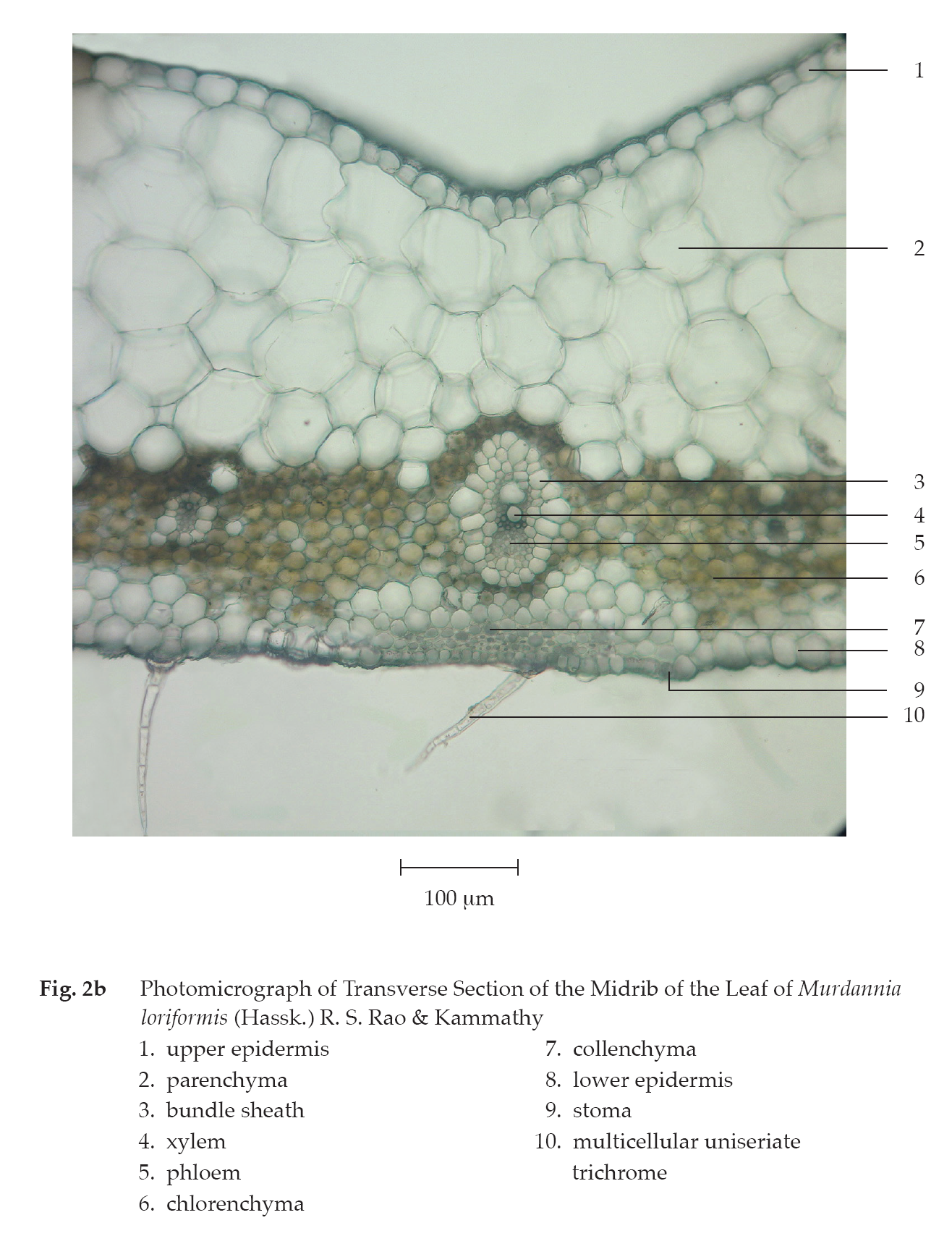
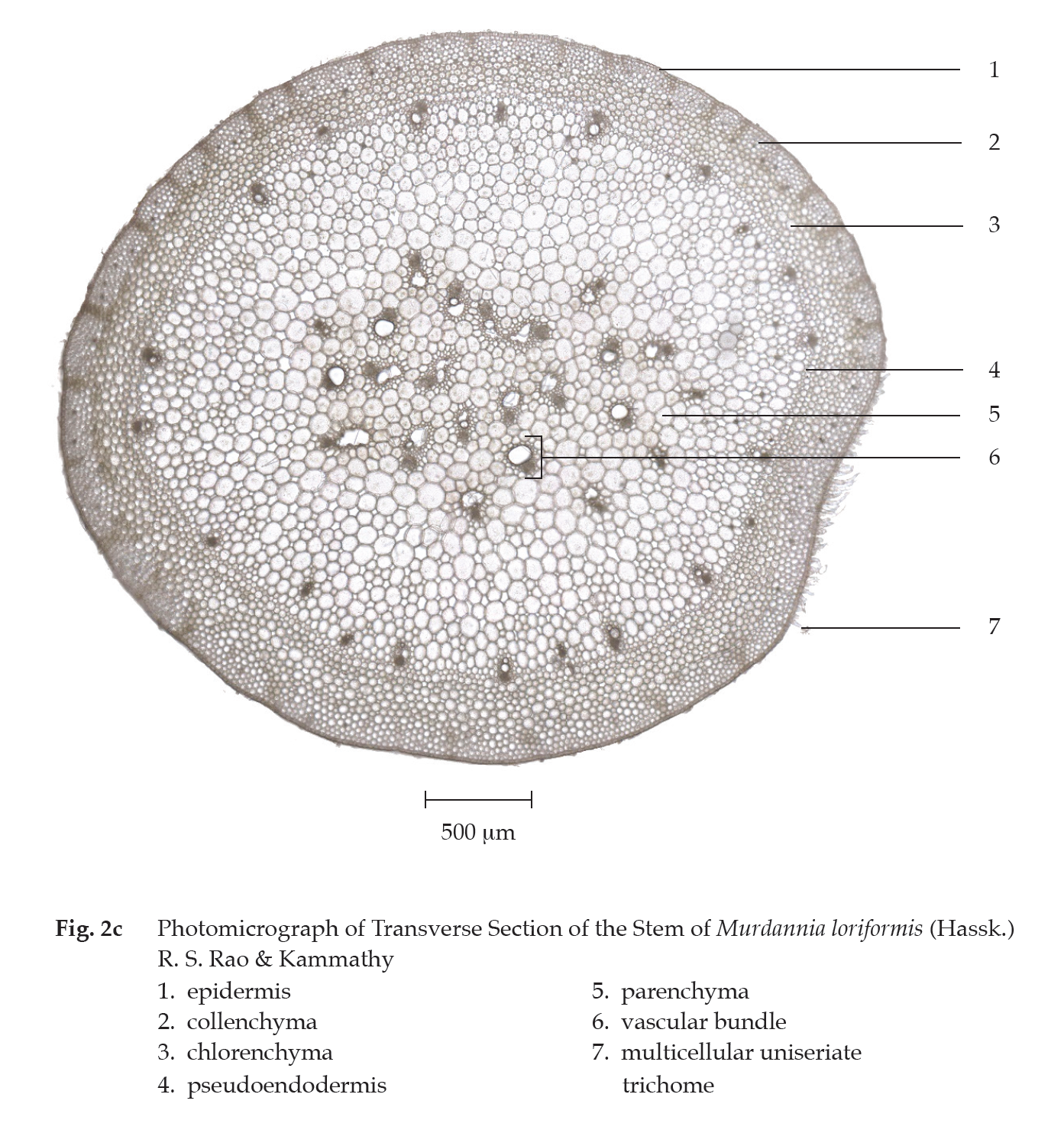
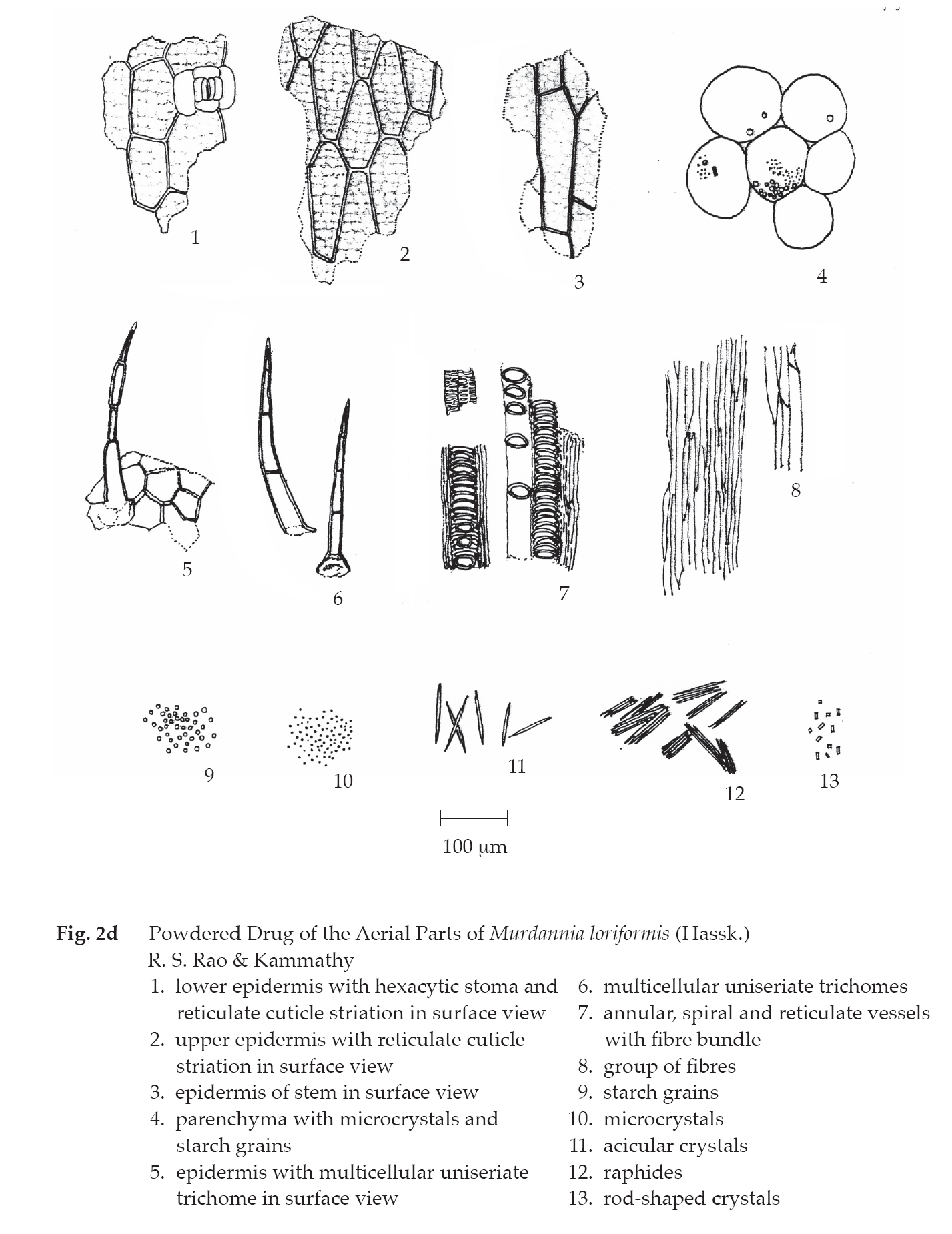
Transverse section of the stem shows epidermis, cortex and vascular bundles. Epidermis, rectangular cells, multicellular uniseriate trichomes and covering cuticle layer. Cortex, collenchyma, chlorenchyma, polygonal parenchyma cells, some containing starch grains, yellowish brown pigment, microcrystals, raphide, acicular and rod-shaped crystals, and a layer of pseudoendodermis. Vascular bundles, scattering in the cortex.
Murdannia Loriformis Herb in powder possesses the diagnostic microscopical characters of the unground drug. Epidermal layers with reticulate cuticle striation and multicellular uniseriate trichome (mostly 4 cells) are characteristic. Large parenchyma with microcrystals, and acicular, rod-shaped or raphide crystals, can also be seen.
Additional information Ethnomedically, the ground fresh aerial parts of murdannia loriformis herb are squeezed with sufficient amount of drinking water and allowed to settle. The clear supernatant is orally taken.
Packaging and storage Murdannia Loriformis Herb shall be kept in well-closed containers, protected from light, and stored in a dry place.
Identification
A. To 1 g of the sample, in powder, add 10 mL of ethanol, warm on a water-bath for 15 minutes and filter. Evaporate the filtrate to dryness in a porcelain dish, dissolve the residue in 5 drops of acetic anhydride and slowly add a few drops of sulfuric acid along the inner side of the dish: a blue-green colour is produced.
B. Carry out the test as described in the “Thin-Layer Chromatography” (Appendix 3.1), using silica gel GF254 as the coating substance and a mixture of 85 volumes of chloroform and 15 volumes of methanol as the mobile phase. Apply separately to the plate, 30 μL of solution (A) as a band of 8 mm and 3 μL of solution (B) as a spot. Prepare solution (A) by refluxing 1 g of the sample, in powder, with 20 mL of ethanol on a water-bath for 15 minutes, filtering and evaporating the filtrate to dryness. Dissolve the residue in 1 mL of methanol. For solution (B), dissolve 1 mg of β-sitosteryl-β-D-glucoside in 1 mL of methanol. After removal of the plate, allow it to dry in air and examine under ultraviolet light (254 nm), marking the quenching bands. Subsequently examine the plate under ultraviolet light (366 nm); several fluorescent bands of different colours are observed (Table 1); see also Fig. 3. Spray the plate with a 10 per cent v/v solution of sulfuric acid in ethanol and heat at 110° for 1 to 2 minutes. The chromatogram obtained from solution (A) shows a purple band (hRf value 28 to 29) corresponding to the spot of β-sitosteryl-β-D-glucoside from solution (B). Several other purple bands are also observed (Table 1); see also Fig. 3.

Loss on drying Not more than 9.0 per cent w/w after drying at 105° to constant weight (Appendix 4.15).
Foreign matter Not more than 2.0 per cent w/w (Appendix 7.2).
Acid-insoluble ash Not more than 14.0 per cent w/w (Appendix 7.6).
Total ash Not more than 23.0 per cent w/w (Appendix 7.7).
Ethanol-soluble extractive Not less than 5.0 per cent w/w (Appendix 7.12).
Water-soluble extractive Not less than 19.0 per cent w/w (Appendix 7.12).
Swelling index Not less than 7.0, when determined by the following method.
Place about 1 g of Murdannia Loriformis Herb, in coarse powder, accurately weighed, in a 25-mL glass-stoppered cylinder graduated over a height of 125±5 mm in 0.5-mL divisions. Moisten it with 1.0 mL of ethanol, add 25 mL of water and close the cylinder. Shake vigorously every 10 minutes for 1 hour. Allow to stand for 3 hours. At 90 minutes after the beginning of the test, release any large volume of liquid in the layer of the Herb and any particles of the Herb floating at the surface of the liquid by rotating the cylinder about a vertical axis. Measure the volume occupied by the Herb, including any adhering mucilage. Carry out three tests at the same time. The swelling index is determined by the mean of the three tests.
